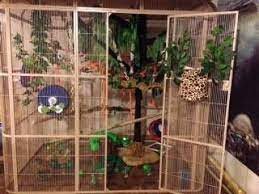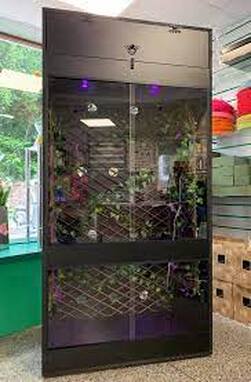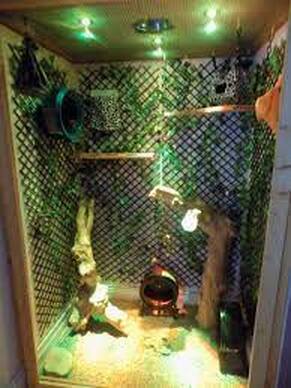General Information:
We've noticed that sugar gliders are an exotic animal with so many misconceptions and misinformation surrounding their care. This is partly due to a lack of education as well as a lack of research surrounding proper husbandry. You must be well educated before committing to a pet sugar glider as many of the most common health issues seen in captivity are the result of poor husbandry.
Sugar gliders are undeniably an absolutely adorable gliding marsupial. Marsupials are not rodents, not even close. In fact, sugar gliders closer to Kangaroos - and, like most marsupials, carry their young within a pouch. The sugar glider is commonly found throughout mainland Australia, New Guinea, Tasmania, and other local areas.
They're nocturnal, and their omnivorous diet is incredibly challenging to replicate in captivity (we will touch on that later). They're highly social mammals and it can often be found living in groups of up to 10 in the wild.
Given their extreme husbandry requirements and frequent cases of neglect seen in captivity, keeping them in captivity should be discouraged.
They have an average lifespan of 7 years.
Care:
Housing/Enrichment:
Sugar gliders are marsupials native to Australia and New Guinea. They have a range of habitats that are primarily forests in either tropical, coastal, or dry inland sclerophyll tropical . They are a social, nocturnal and arboreal species. Their anatomy has evolved to be perfectly adapted to their native environment. Sugar gliders are able to glide (up to 50m) as their name suggests. They belong to the family Petauridae which translates to ‘wrist-winged gliders. They have a thin gliding membrane called the patagium that extends from the fifth digit of the forepaws to their ankles, and their tail is somewhat prehensile which helps them move safely and effectively around their home environment. Their eyes are large, protruding, and widely spaced giving them a large field of vision well adapted to seeing at night.
Enclosures should be as large as possible, sources state a minimum of 2m wide by 2m long and at least 1.8m high, but a larger enclosure is always better. Should the enclosure be made from mesh, it should be no wider than 1.25-2.5cm to prevent injury and escapes. It is preferred for the wire to be made of stainless steel coated in PVC as sugar gliders are prone to zinc poisoning.
It is important to consider the climate you live in, for example, in the UK it is far more beneficial to house sugar gliders in a vivarium type set up as the temperature and humidity can be far more easily regulated. Even heating an entire room would be challenging to be of a suitable and consistent temperature would be challenging. A human home may be at the lower end of their metabolic tolerance and comfort zone. Their preferred temperature range is 27°C to 31°C, but they can tolerate ranges as much as 15°C to 32°C. If additional heating is required, please ensure to use a thermostat as well as a thermometer to manage heating.
Nest areas are essential and should be positioned high in the cage, but not too high so that the glider will potentially tear their membrane when landing on the top, and with sufficient space between nest boxes to prevent territorial aggression. Providing vertical trees, ropes, and branches will allow for natural gliding behaviour. Some sugar glides appreciate safe bird toys available for additional enrichment. It is advised to place food into feeders high off the ground, and nectar can be placed on trees within their accommodation. The base of the cage can be filled with safe aspen or paper substrate which will need to be spot cleaned daily and fully emptied at least weekly.
Socialising:
You should never keep sugar gliders alone as it can cause them to become very depressed and display stereotypical behaviours. You can cohabit males and females provided the male(s) are neutered (castrating male sugar gliders is a relatively simple procedure if performed by an experienced vet). Sugar gliders naturally live in quite large groups.
Some sugar gliders can be quite nippy, especially when they're not handled. When handling your sugar glider outside of their cage, please ensure the area is safe so that your pet cannot injure themselves.
Diet:
A sugar gliders diet is arguably one of, if not the most difficult part of their care. You must feed your sugar gliders a suitable diet. Malnutrition can lead to dental diseases, metabolic bone disease, dehydration, and more.
A wild sugar glider would mostly consume sap, honeydew from nectar-eating insects, insects, manna, bird eggs, eucalyptus gum, lizards, small birds, and fruits.
It's important to note that a sugar gliders diet should not contain more phosphorus than calcium as this leads them susceptible to countless injuries and illnesses.
Exotic veterinarians and experienced keepers recommend:
Personally, our preferred recipes are the, SGS2 diet (preferred), or, the Leadbeater's recipe.
SGS || Diet:
The Leadbeater's recipe:
Refrigerate unused portions.
Treats can include various live insects and well as some alternations of fruits and vegetables.
Many suitable vitamin/mineral powders are available but branded for reptiles. You can use reptile multivitamin and calcium with D3.
Please feel free to ask more questions.
You should never keep sugar gliders alone as it can cause them to become very depressed and display stereotypical behaviours. You can cohabit males and females provided the male(s) are neutered (castrating male sugar gliders is a relatively simple procedure if performed by an experienced vet). Sugar gliders naturally live in quite large groups.
Some sugar gliders can be quite nippy, especially when they're not handled. When handling your sugar glider outside of their cage, please ensure the area is safe so that your pet cannot injure themselves.
Diet:
A sugar gliders diet is arguably one of, if not the most difficult part of their care. You must feed your sugar gliders a suitable diet. Malnutrition can lead to dental diseases, metabolic bone disease, dehydration, and more.
A wild sugar glider would mostly consume sap, honeydew from nectar-eating insects, insects, manna, bird eggs, eucalyptus gum, lizards, small birds, and fruits.
It's important to note that a sugar gliders diet should not contain more phosphorus than calcium as this leads them susceptible to countless injuries and illnesses.
Exotic veterinarians and experienced keepers recommend:
- 2:1 ratio between calcium and phosphorus
- 40% protein for non-breeding sugar gliders
- Avoid excessive fats
- Avoid refined sugars.
Personally, our preferred recipes are the, SGS2 diet (preferred), or, the Leadbeater's recipe.
SGS || Diet:
- 450g fruit and vegetables; preferably using a lot of butternut squash, sweet potato and carrot. The fruit varies but preferably use papaya, apple, pear – lots of recipes can be found on Sugar Gliders UK Facebook page.
- 2 teaspoons of High Protein Supplement
- 1 teaspoon of bee pollen
- 1 quarter of a teaspoon of acacia gum
- 1 tablespoon of brown linseed soaked in 3 – 4 tablespoons of boiling water
- 1 heaped tablespoon of oatmeal
- 1 tablespoon of natural probiotic yogurt
- 1 half teaspoon of spirulina
- 1 peeled hard boiled egg
- Calcium should be given 2 – 3 times a week. When using calcium powder, make 2 batches, one with half a teaspoon of calcium and one without. Mark them up clearly and feed accordingly.
- Gliderade is also given 2 – 3 times a week – you can give this on the calcium free days.
The Leadbeater's recipe:
- 150ml honey
- 150ml warmed water
- 1 shelled boiled egg
- 25g of high protein baby cereal
- 1tsp of mineral and vitamin supplement - do not add to the water supply.
Refrigerate unused portions.
Treats can include various live insects and well as some alternations of fruits and vegetables.
Many suitable vitamin/mineral powders are available but branded for reptiles. You can use reptile multivitamin and calcium with D3.
Please feel free to ask more questions.



